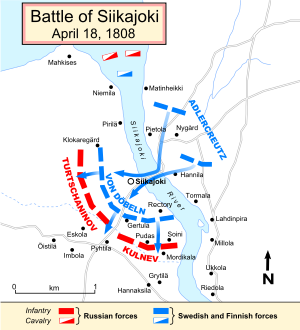Battle of Siikajoki
This article needs additional citations for verification. (October 2016) |
| Battle of Siikajoki | |||||||
|---|---|---|---|---|---|---|---|
| Part of the Finnish War | |||||||
 Positions at the battle | |||||||
| |||||||
| Belligerents | |||||||
| | | ||||||
| Commanders and leaders | |||||||
| | | ||||||
| Strength | |||||||
| 6,000–7,000[1] | 2,000–2,400[2][3][1] | ||||||
| Casualties and losses | |||||||
| 205 killed, wounded or captured[4] | 387 killed, wounded or captured[4] | ||||||
The Battle of Siikajoki (Finnish: Siikajoen taistelu) was fought between Swedish and Russian troops on 18 April 1808 at Siikajoki, approximately 60 km south of Uleåborg, Swedish Finland (today Oulu, Republic of Finland). During the first stage of the Finnish War, the Swedish commander Wilhelm Mauritz Klingspor had decided to retreat from southern Finland, so that the Swedes would gain time, and more troops could be moved to Finland via Tornio. The retreat was also made in an effort to delay battles until the seas thawed, and to reserve troops in case the Danes took the opportunity to attack Sweden.
The Battle of Pyhäjoki, which had been fought two days earlier, was one of the first skirmishes of the war, but Siikajoki was the first major attempt to stop the advancing Russians. Carl Johan Adlercreutz had been appointed commander after Count Gustaf Löwenhielm had been captured by the Russian at Pyhäjoki. The force commanded by Georg Carl von Döbeln was trying to cross the Siikajoki River when the Russians caught up with his force. Von Döbeln decided to take a stance on the south bank of the river. He first ordered a counterattack, but was forced to pull back. At that point the Russian center opened up and the newly appointed General-Adjutant Adlercreutz ordered another attack, which threw the Russians back and halted their advance.
The Battle of Siikajoki is described in the poem "Adlercreutz" in Runeberg's epic Tales of Ensign Stål.
The Nyland Regiment distinguished themselves at the battle, and today the Siikajoki Cross can be worn by soldiers of the Nyland Brigade, which is the traditional heir, though now part of the Finnish Navy.
Swedish regiments
[edit]1st Brigade
[edit]- Åbo Infantry Regiment (3 battalions)
- Nyland Infantry Regiment (1 battalion)
- Nyland Jägers (1 company)
- Nyland Dragoon Regiment (2 squadrons)
- Finnish Artillery Regiment
2nd Brigade
[edit]- Björneborg Infantry Regiment (3 battalions)
- Österbotten Infantry Regiment (1 battalion and 1 company)
- Nyland Dragoon Regiment (2 squadrons)
- Finnish Artillery Regiment
3rd Brigade
[edit]- Tavastehus Infantry Regiment (3 battalions)
- Nyland Infantry Regiment (1 battalion)
- Nyland Dragoon Regiment (3 squadrons)
- Finnish Artillery Regiment
Citations and sources
[edit]Citations
[edit]- ^ a b Hornborg 1955, p. 89.
- ^ Военный энциклопедический лексикон. СПб. Т. XI. 1856. С. 115
- ^ Захаров Г. Т. Русско-шведская война 1808—1809. М., 1940. С. 30
- ^ a b Hornborg 1955, p. 92.
Sources
[edit]- Hornborg, Eirik (1955). När riket sprängdes: fälttågen i Finland och Västerbotten, 1808-1809 (in Swedish). Stockholm: P. A. Norstedts och Söners Förlag.
External links
[edit]![]() Media related to Battle of Siikajoki at Wikimedia Commons
Media related to Battle of Siikajoki at Wikimedia Commons


 French
French Deutsch
Deutsch